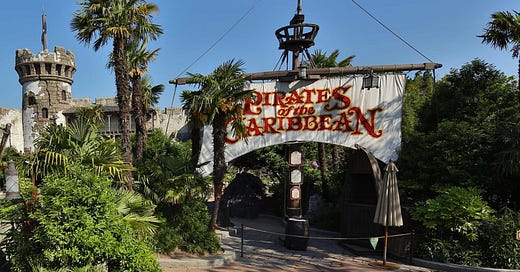Fetid water drips from the ceiling and runs down the stone walls. The air is thick and humid and uncomfortable. I shuffle forward with my fellow captives, through the bowels of the fortress, deeper and deeper into the darkness of the dungeons. Through the bars of cells I see my fate in the hanging skeletons, ragged clothes the only hints of their past lives. Torchlight splashes off surfaces, casting everything in a sickly yellow.
We’re led out of the fortress’ passageways into the night, the dock below and the sky inky black. The path winds down the side of the cliff, past palm trees and incongruous bins. Each of us is loaded onto a boat and we drift away on the tide towards the sound of distant cannon fire...
So many bins! Other than that, though, this was the impeccable, immersive introduction to the Pirates of the Caribbean ride at Disneyland Paris, and the moment that the entire park clicked with me.
My son is 10 so it seemed like now or never for visiting, plus they’ve added Marvel and Star Wars rides on top of the classic Disney stuff which we knew would appeal more to him. In typical adult fashion, I had slightly assumed it would be one of those ‘put up with it for the sake of the kid’ holidays. Like that time we went to Devon.
I was very wrong!
Keep reading with a 7-day free trial
Subscribe to Write More with Simon K Jones to keep reading this post and get 7 days of free access to the full post archives.




